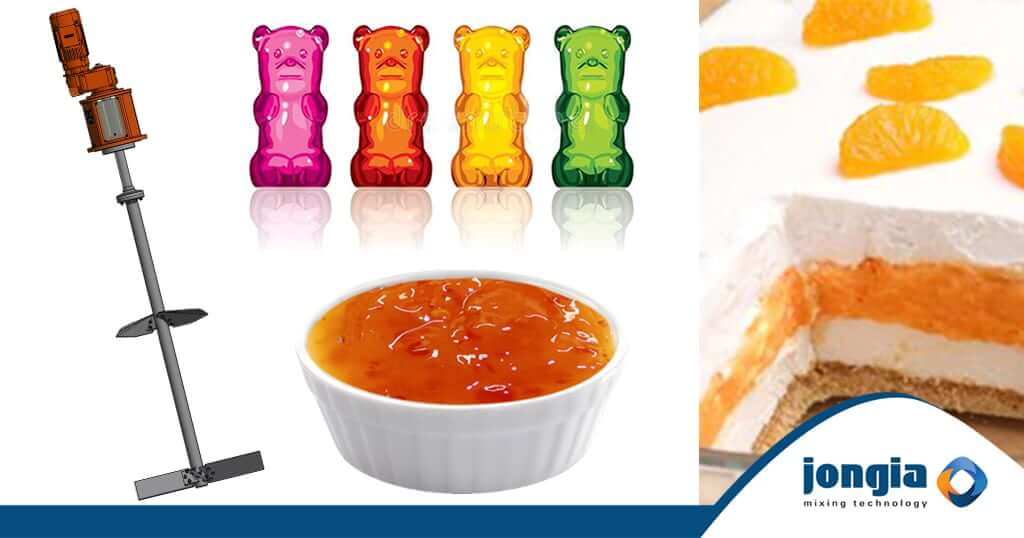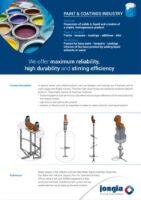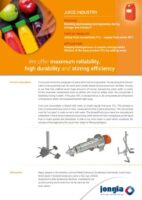Starch is one of the most important polysaccharides that exists and is also an important component in many food crops, including rice, beans, corn and wheat. Starch is used on a large scale in a wide variety of applications. In the food industry especially, native starches are utilized in regulating texture and controlling moisture levels. It is also a great stabilizer in various products. Jongia Mixing Technology has initiated numerous mixing processes all over the world, using her agitators for modifying starches from native starch and converting them into usable products.
What is starch gelatinization?
An example product with native starch as a component is gel. This smooth and stable gel, which is a basis for food applications, can be obtained through the process of starch gelatinization. In this process, starch and water are heated up, enabling the starch granules to bind and swell. This usually happens at a temperature between 60 and 80 degrees Celsius. When the starch is sufficiently heated, it will gradually absorb the water. As temperatures increase, the starch granules slowly start losing their crystallinity and turn amorphous (a solid state without crystalline structure). In reaction to this, the starch thickens into a product called ‘gel’, or sometimes ‘gum’.
The procedure as a whole gives the starch gel a softening texture, becoming a versatile product to be used in sauces, puddings, cream, candy and other food products.
Producing the appropriate starch gel requires choosing the correct native starch type to fit its intended purpose. The correct chosen type of native starch will react to temperature, heating rate, pH grade, and water amount to become the perfect gel.
Right agitator produces optimal result
It is important to find the right agitator for starch gelatinization. When the starch is mixed correctly during the heating process, it will turn slightly transparent and its texture will become viscous. An incorrect mixing process will result in a lumpy and unstable product. There are many different agitators suitable for starch gelatinization, as long as they create a sufficient amount of shear during the process and are able to keep the volume homogenous throughout the entire heating process.
The gelatinization process starts at a low viscosity of 1cP and ends at the much higher viscosity of around 2000cP. For this, the agitators need to be able to create sufficient flow and shear, while also maintaining enough thrust to continually function throughout the entire process to avoid foaming and lumping.
Combination of agitator and tank
In order to focus on these challenges of mixing, Jongia Mixing Technology usually applies a combination of a Hydrofoil Turbine and an Axial Flow Turbine as mixing elements. For mixing native starch solids with liquids, there needs to be sufficient flow and shear. The Jongia Hydrofoil creates an axial flow in a top-to-bottom direction inside the tank. At the bottom of the shaft, a Jongia Axial Flow Turbine receives the product from the Hydrofoil and mixes the starch solids with the liquid, creating a homogenous blend.
In this specific mixing process, the heat dissipated through the tank wall must be re-introduced into the product. This requires a sufficiently strong flow, as this heat transfer also increases viscosity. The Axial Flow Turbine makes the perfect fit for this purpose. This Turbine will create sufficient shear for mixing the solids with the liquid, while providing the enormous amount of thrust needed to ensure the heat from the tank wall is applied thoroughly to the entire product. Such processes are usually initiated with the use of a Top Entry agitator, since both mixing elements fit on a single vertical axis and utilize the entire tank geometry to ensure the desired mixture.
Want to know more?
Like all mixing processes, the mixing process of starch gelatinization requires a specific approach. Jongia Mixing Technology possesses all expertise and experience to give broad advice regarding this product. If you have any questions, please do not hesitate to contact us.
Contact our specialized team for all your questions

Tom Pruymboom
Sales Director
Area Worldwide

Bart Brouwer
Area Sales Manager
Area Worldwide
Technical Questions?

Sijko van der Veen
Application Engineer
Technical Specialist

Sijko van der Veen
Application Engineer
Technical Specialist

The mixing process of starch gelatinization
Starch is one of the most important polysaccharides that exists and is also an important component in many food crops, including rice, beans, corn and wheat. Starch is used on a large scale in a wide variety of applications. In
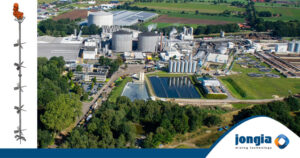
Customized agitators make for a satisfied starch manufacturer
Native starch is used as base material in many applications. Native starches manage texture, control moisture content, and stabilize products, making them the ideal material for food applications. About native starches Native starches are insoluble in cold water and swell

The introduction of native starch in the mixing process
Jongia Mixing Technology has initiated numerous mixing processes all over the world using her agitators. In some of these mixing processes, native starch was one of the products to be mixed. Native Starch is used on a large scale in
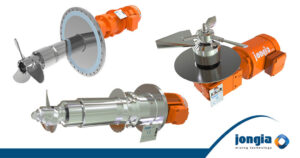
The Jongia Magitator: A multi-purpose magnetic agitator
To keep dairy or starch products homogeneous, the Jongia Mixing Technology Magitator, a magnet-driven agitator, is the right choice. In addition, this agitator maintains vegetable oil or juices at the right temperature. USP’s of the Magitator Opting for the Magitator
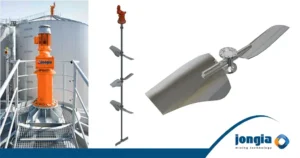
The Hydroprop: energy efficient agitator for the biogas industry
To keep starch in suspension, for crystallization processes and to keep a biogas process in motion, Jongia Mixing Technology has a perfect mixing element in its range: The Hydroprop. However, what kind of questions do the customers have? And what

Joint project leads to fruitful cooperation
Since 2016, Sigma Process Technologies, located in Turkey, has been one of Jongia Mixing Technology’s important partners. Sigma Process Technologies is active in the starch industry in Turkey and beyond, an area in which Jongia Mixing Technology also sees opportunities


